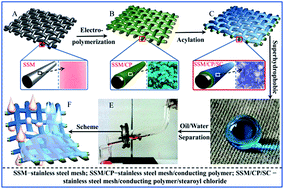Ultrastable coaxial cable-like superhydrophobic mesh with self-adaption effect: facile synthesis and oil/water separation application†
Abstract
A coaxial cable-like stainless steel wire@conducting polymer (polyaniline or polypyrrole) with special hierarchical micro–nanoscale roughness was successfully synthesized using a facile, inexpensive and controlled pulse electro-polymerization method (PPM). Conjugated with stearoyl chloride (SC) through an acylation reaction, the obtained meshes exhibit both superhydrophobic and superoleophilic properties with a water contact angle of 154° and an oil contact angle of 0°, which was successfully applied in separating a series of oil/water mixtures with a separation efficiency of over 98%. The separation efficiency also remains high even after 25 reuse cycles (99.90% for a hexane/water mixture). More importantly, owing to their self-adaption aging protection and antioxidant properties, the obtained meshes retain ultrastable superhydrophobicity and high separation efficiency in long-term storage, ultrasonic treatment, and even under extreme environment conditions of strong acidic, alkaline, hyperhaline and oxidizing solutions. In addition, electrochemical measurements indicate that the corrosion dynamic rate of the superhydrophobic mesh is 1/60 lower than that of bare stainless steel mesh. Therefore, this work provides a novel method to fabricate a high quality superhydrophobic and superoleophilic mesh for effective oil/water separation.

- This article is part of the themed collection: 2016 Journal of Materials Chemistry A HOT Papers

 Please wait while we load your content...
Please wait while we load your content...